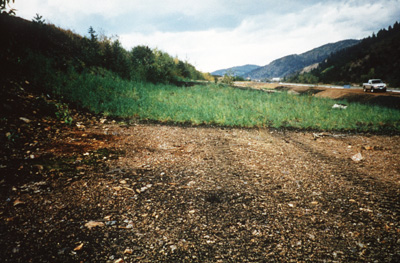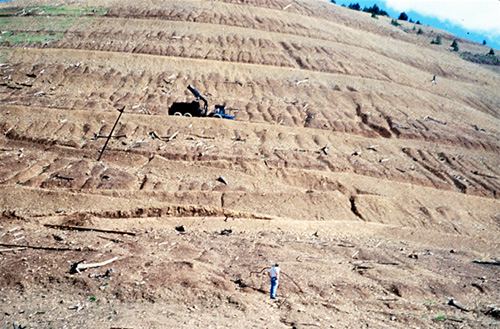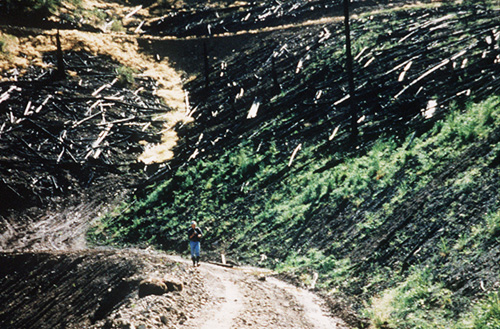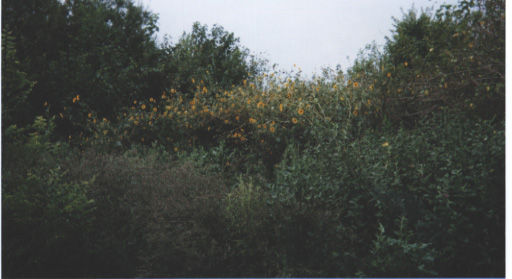
May 1998
Biosolids and Fly Ash Used to Restore the Bunker Hill Superfund Site
Sally Brown, Ph.D., U.S. Department of Agriculture, Agricultural Research Service; Chuck Henry, Ph.D., University of Washington; Rufus Chaney, Ph.D., U.S. Department of Agriculture, Agricultural Research Service
Application of a remediation mixture of municipal biosolids, wood ash, and log yard wood waste is proving highly effective in reducing erosion, correcting soil pH, and supporting a self-sustaining vegetative cover at the Bunker Hill, ID, Superfund site. In addition, levels of zinc, cadmium, and copper in vegetation are within normal ranges (less than 300 ppm zinc, 0.5-5 ppm cadmium, and 6-30 ppm copper) for plants growing on the treated areas. Revegetation of more than 1,000 acres on this site is a problem due to deficiencies of certain nutrients as well as toxic levels of other elements. In the past, these areas were incapable of supporting any vegetation.
Experts from the U.S. Department of Agriculture, University of Washington, University of Idaho, the Northwest Biosolids Management Association, Washington Water Power, and EPA are collaborating in this effort to re-establish native plant communities and reduce contaminant levels in this severely disturbed area. Direct visual comparison of one of the treated areas with the project control plot is shown below.

Control plot (foreground) and a treated area (background) at
the Bunker Hill site.
The Bunker Hill site, located in the Coeur d’Alene River Basin, is the second largest Superfund site in the nation. Zinc and lead mining/smelting was conducted in the area for over 60 years, resulting in soils with extremely high metal concentrations, low pH levels, high susceptibility to erosion, low microbial growth levels, and low water-holding capacity. Earlier restoration efforts involving the construction of terraces (on slopes exceeding 50 percent) and addition of limestone and fertilizers were not successful in establishing a vegetative cover. Demonstration and pilot-scale plots were installed in the spring and fall of 1997 in order to evaluate the success of biosolid/fly ash applications.
Local sources of the application materials were used exclusively. Biosolids provided by three different municipal areas (Biosolids 1, 2, and 3) were mixed with a 1:1 (by volume) blend of wood ash from local power generators and log yard wood waste from a nearby railroad company. Biosolids were mixed and applied at a rate of 25 and 50 dry tons/acre (t/a). Ash was applied at a constant rate of 100 wet t/a to provide 22 t/a calcium carbonate equivalent. The log yard wood waste was added at a fixed volume ratio of 1:5. Prior to surface application (at a rate of 30 pounds/acre), a seeding mixture of grasses and legumes was added to the biosolids/ash amendment mixture. This mixture formed a highly adhesive product that could remain on the eroded hillsides, while simultaneously permitting seedling emergence and increasing water permeability.
Two months after treatment of two- to three-acre test plots, increased levels of highly diverse microbial populations were observed in soils directly below the treated surface. No microbial activity was detected on control soils. Samples taken from plants six months after initial application of each of the three biosolid mixtures indicate reduced levels of toxic metals and increased levels of soil nutrients (as shown in Figure 1). These data indicate that the amendment re-establishes normal concentration levels of these metals, whereby the metals are neither nutritionally deficient or toxic.
| Figure 1. Average Elemental Concentrations in Plants | |||||
| Zinc (mg/kg) |
Cadmium (mg/kg) |
Copper (mg/kg) |
Phosphorus (g/kg) |
Potassium (g/kg) |
|
|---|---|---|---|---|---|
| Control Plot | 215 | 0.4 | 3.9 | 590 | 10 |
| Biosolid 1 | 150 | 2.3 | 11.4 | 3,800 | 38 |
| Biosolid 2 | 108 | 0.6 | 9.9 | 6,830 | 26 |
| Biosolid 3 | 59 | 0.9 | 13.8 | 6,110 | 25 |

June 1997 view of an untreated Bunker Hill Area.

October 1997 view of the same Bunker Hill area following
treatment.
In the fall of 1997, a second phase of the study was initiated to determine the effectiveness of different locally available residual materials, compare ratios of different amendments, determine the most effective seeding time, and predict long-term fate of restoration efforts. Four different biosolids were used, in addition to three different wood ashes, two composts, one type of pulp and paper sludge, and log yard waste. No movement of material from the test plots has occurred, despite several erosive weather events.
Full germination of grasses and legumes is expected by this spring. An additional study, to cover approximately 20 acres, is slated to be established at Bunker Hill or a similar site this summer. The study will focus on development of steep slope application technology, and will establish a long-term ecological research station to monitor the effects of this technology on native biota. A manual of practice for these and similar restoration methods used around the nation will be developed. For additional information, contact Dr. Sally Brown (U.S. Department of Agriculture, Agricultural Research Service) at 301-504-9230.
Long-Term Phytoremediation of Organic Soil Pollutants
John S. Fletcher, Ph.D., University of Oklahoma, and Sunil I. Shah, Union Carbide Corp.
Research at a former industrial sludge lagoon is underway to evaluate phytoremediation of recalcitrant organic compounds on a time scale that is realistic for slow natural processes. University of Oklahoma researchers are working with Union Carbide at a Texas site to determine how a mixture of contaminants has influenced ecological events over time and, in turn, how an evolving plant-microbe community has influenced the fate (degradation and/or immobilization) of the contaminants. Results indicate that chemicals in the study area, in combination with natural environmental stresses (i.e., periodic drought) over a 15-year period have screened for plant species capable of growing under the combined influence of both chemical and natural environmental stresses.
The study area comprises one acre that was taken out of use as an industrial sludge lagoon and drained approximately 20 years ago, leaving high levels of polyaromatic hydrocarbons (PAHs) (as high as 20,000 ppm, total) and BTEX compounds (benzene, toluene, ethylbenzene, and xylenes) in the sludge. Since then, the entire site has been revegetated as a result of natural processes starting with seed dispersal from mature vegetation growing in the vicinity of the basin. A healthy, biodiverse community of 51 different plant species is growing on the site now.

A healthy, biodiverse community of plants growing at the former
industrial sludge lagoon.
Researchers compared the density of seed-donor plants growing within a 1,200-meter radius of the sludge basin with vegetation in the basin, finding the composition of the basin plant community does not reflect nearby seed-donor populations (Figure 2). Most notable is the prominence of mulberry and the absence of Chinese tallow and willow in the basin. These differences are attributed to natural screening processes whereby the current plant populations have proved to be more capable of growth in the existing chemical and environmental conditions of the basin. In earlier laboratory screening studies on rhizosphere enhancement of microbial degradation, mulberry was identified as the potentially most influential species among the 17 plants tested under similar conditions.
| Figure 2. Comparison of Dominant Vegetation | ||
| In Sludge Basin* | Radius of Basin* | |
|---|---|---|
| Morus rubra (mulberry tree) | 36.2 | 5.0 |
| Cyndon dactylon (Bermuda grass) | 18.9 | 9.0 |
| Helianthus annuus (sunflower) | 9.4 | 2.0 |
| Celtis laevigata (sugarberry tree) | 2.8 | 7.0 |
| Salix nigra (willow tree) | 0 | 2.0 |
| Baccharis halimifolia (Baccharis bush) | 1.9 | 25.0 |
| Sapium sebiferum (Chinese tallow tree) | 0 | 27.0 |
| Total percent | 85.3 | 97.8 |
| * Percent relative convergence/abundance | ||
Field data collected at the sludge basin indicate that the concentration of PAHs in the top two feet of material beneath mature mulberry trees is only 10-20% of the concentration originally deposited in the sludge. The concentration of contaminants in the lower root zone (2-4 feet) of mulberry averages about 50% of that present in sludge beneath the root zone. PAH-degrading bacteria have been isolated from the rhizosphere, but not from the non-rooted sludge material at 6-foot depths. These data indicate that mulberry seems to have the capacity for sustained growth in PAH/BETX-contaminated sludge under natural conditions, and that its root zone fosters the degradation of industrial contaminants presumably by substrate release and increased soil aeration during root turnover.
Additional field and laboratory tests are underway to evaluate mulberry’s phytoremediation potential and to develop ecologically sound and safe phytoremediation strategies for sustained, long-term (15-20 years) degradation of recalcitrant pollutants at hazardous waste sites. Contact Dr. John Fletcher (University of Oklahoma, Department of Botany and Microbiology) at 405-325-3174 or Sunil I Shah (Union Carbide Corporation) at 304-747-5234 for more information.
Phytoremediation of Selenium-Laden Soils
Gary Bañuelos, Ph.D., U.S. Department of Agriculture, Agricultural Research Service
The U.S. Department of Agriculture (USDA) is conducting two large-scale field studies in areas of central California where intense agricultural use of the land has resulted in potentially toxic levels of naturally-occurring selenium in soils. USDA study results indicate that Brassica species (such as mustard and canola) can be used to hyperaccumulate and volatilize soluble selenium in soil. Field data also show that phytoremediation may provide a practical and economically viable method for reducing the selenium load discharge into effluent in irrigated regions of central California. Other western states with extensive shale deposits, where increased irrigation of agricultural lands is increasing selenium solubilization, may benefit from this approach.
Under greenhouse conditions, researchers found that selenium concentrations fell by nearly 50% after a period of 3-4 months, with tissue concentrations of selenium reaching levels as high as 600 ppm in dry plant material. After four years of crop rotations at one of the California study sites with Brassica species, kenaf, and tall fescue, total soil concentrations of selenium fell by 25% from levels of 1.5-2.0 ppm. Concentrations of soluble boron, which is often found in conjunction with selenium and also potentially toxic to plants in high concentrations, fell by nearly 20% from levels of 5-15 ppm. New eucalyptus trees subsequently were replanted at this site and intercropped with tall fescue, which continues to manage the level of selenium to a safe level predominantly through plant volatilization.
On the second study site, poor-quality ground water with high salinity, boron, and selenium is used as irrigation water on Brassica species planted for phytoremediation. Following two years of research, Brassica species now are used in crop rotation with other agronomic crops, such as sugar beets and wheat, to maintain low selenium levels whenever poor quality water is used for irrigation. Additionally, minimizing the buildup of soil selenium allows for effective leaching of salts such as boron out of the soil profile. The planting of Brassica, itself, provides opportunities for the production of oil as an agronomic crop and for animal forage (pending regulatory approval).
This approach to phytoremediation relies upon combination of Brassica with other plants, such as alfalfa or grasses, that primarily volatilize selenium. In general, USDA recommends consideration of certain factors before implementing phytoremediation, including: (1) soil salinity and high concentrations of toxic elements; (2) the presence of competitive ions affecting chemical uptake; (3) adverse climatic conditions; (4) water management strategies that produce little effluent; (5)unwanted plant consumption by wildlife and insects; (6) plant destruction/utilization; and (7) stakeholder acceptance.
These studies were precipitated, in part, by the bioconcentration and apparent toxicity of selenium found in the wetland food chain at Kesterson National Wildlife Refuge in central California. Researchers identified high rates of embryo deformities and mortalities in aquatic birds resulting from agricultural drainage to the refuge. The USDA estimates that more than 500,000 acres of soil in central California possibly are susceptible to producing selenium-laden effluent. For more information, contact Gary Bañuelos (USDA, Agricultural Research Service) at 209-453-3100.
Biodegradation of De-Icing Fluids
Charles A. Bleckmann, Ph.D., Air Force Institute of Technology
Investigations conducted by the U.S. Air Force Institute of Technology (AFIT), Wright-Patterson Air Force Base, OH, have shown that a component of aircraft de-icing fluids—propylene glycol—readily degrades in both high clay and sandy soil systems. As the primary components of commercial aircraft de-icing fluids, both propylene glycol and ethylene glycol commonly are detected in streams receiving runoff from airports. Their degradation creates a high oxygen demand capable of disrupting receiving streams. Collection and subsequent treatment of spent fluids by land application may be considered a remediation technique.
In soil test systems, AFIT researchers measured oxygen consumption and carbon dioxide production (the process of respirometry) involved in propylene glycol degradation. Respirometry served as a sensitive measure of biological activity in the laboratory environment, and was used to compare the activity of experimental controls. Propylene glycol concentrations of 3,800-11,400 mg/kg degraded (at 30oC) in 28 days by 20-28% in clay soils, and by 2-6% in sandy soils, without the addition of nutrients. De-icing agent additives such as the corrosion inhibitor tolyltriazole showed little degradation. Contact Capt. Laura Johnson or Lt. AnnMarie Halterman-O’Malley (AFIT) at 937-255-3636 for more information on these studies, or Dr. Charles Bleckmann (AFIT) at 937-255-3636 (phone) or cbleckma@afit.af.mil (e-mail) on other site remediation research conducted by the AFIT Department of Engineering and Environmental Management.
New Phytoremediation Bibliography Now Available
The Phytoremediation Bibliography, recently developed by the EPA Phytoremediation Handbook Team in conjunction with the Remediation Technology Development Forum’s Phytoremediation Action Team, is a comprehensive reference list containing available abstracts and over 1,100 citations on phytoremediation or closely related subjects. The bibliography will be updated quarterly to include additional abstracts and references for peer-reviewed journal articles, conference presentations and posters, book excerpts, and newspaper or magazine articles. Bibliography searches may be conducted on-line from the RTDF Internet site http://www.rtdf.org/public/phyto/phytodoc.htm.
| We now offer a new service-TechDirect-to keep you abreast of new EPA publications and event of interest to site remediation and site characterization professionals. Once a month, a TechDirect message will be sent via email describing new products and instructions on how to obtain them. |






